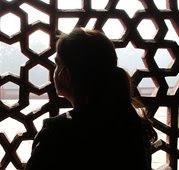So back around Christmas clearance time, I picked up a book on the discount rack at Books a Million. A $4 book is rarely a bad investment, especially when the subject matter seems interesting. And yet, I feel I was ripped off. Just goes to show you that while I wanted to put it on the
book swap anyway, I probably shouldn't have bothered to read it first.
So the book in question was called
Beneath A Marble Sky, written by John Shor. It is a historical fiction novel about the building of the Taj Mahal. The main character is Shah Jahan's eldest daughter, Janahara. The reader receives glimpses into her parents' love life, the life in the court in Agra at that time, and the extensive project that became the Taj Mahal after the main character's mother's death.
As I have little expertise in the history of the place and period (sixteenth century Hindustan), I can only say that the story is pretty pure fiction. With the exception of very well-known historical events, I can find no evidence in my (limited) research to support most of the story. The main character is well drawn, especially for a man writing from a female perspective. Many of the other characters are too stereotypical -- Shah Jahan is always a loving and understanding man, her brothers are either endlessly loving or hating (depending on which one she talks about) and her mother is the wisest person in the world. Yet her two wise and loving parents manage to marry her off to a man who seems to be the most cruel and disgusting guy in Agra. (According to other sources, Jahanara never married.)
The book suffers from a myriad of problems: absolute characters, troublesome tripping over facts, and a lack of plausibility. The few things that I found interesting about court life in Agra were tainted by the idea that perhaps this writer didn't do any research aside from perhaps visiting the places in question. I was especially annoyed at how this Princess of Agra managed to travel to Goa and have no language barrier problem as she dined in a fisherman's hut on the coast.
Altogether, the whole setup is ridiculous. Early on, we are given to understand that Jahanara is telling her granddaughters the story of the building of the Taj Mahal, etc. The idea being so they will know their heritage and that their baby brother may one day be able to ascend to a noble position. Yet, the setup goes nowhere. In the end, there is no resolution. It leaves the reader quite unsatisfied, but relieved that the author didn't see fit to mess with history to the expected extent.
So not a book I would recommend to someone looking for a truthful story about North Indian history at the time of the Taj Mahal's building. I will give the author credit for his descriptions of the mauseleum and the Agra Fort. That at least proved somewhat truthful.
Labels: Agra, books, India, review, Taj Mahal




